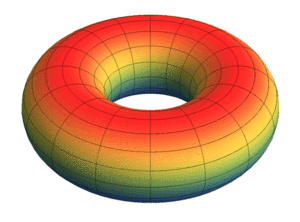Solenoid (mathematics)
- This page discusses a class of topological groups. For the wrapped loop of wire, see Solenoid.

In mathematics, a solenoid is a compact connected topological space (i.e. a continuum) that may be obtained as the inverse limit of an inverse system of topological groups and continuous homomorphisms
- (Si, fi), fi: Si+1 → Si, i ≥ 0,
where each Si is a circle and fi is the map that uniformly wraps the circle Si+1 ni times (ni ≥ 2) around the circle Si. This construction can be carried out geometrically in the three-dimensional Euclidean space R3. A solenoid is a one-dimensional homogeneous indecomposable continuum that has the structure of a compact topological group.
In the special case where all ni have the same value n, so that the inverse system is determined by the multiplication by n self map of the circle, solenoids were first introduced by Vietoris for n = 2 and by van Dantzig for an arbitrary n. Such a solenoid arises as a one-dimensional expanding attractor, or Smale–Williams attractor, and forms an important example in the theory of hyperbolic dynamical systems.
Geometric construction and the Smale–Williams attractor


Each solenoid may be constructed as the intersection of a nested system of embedded solid tori in R3.
Fix a sequence of natural numbers {ni}, ni ≥ 2. Let T0 = S1 × D be a solid torus. For each i ≥ 0, choose a solid torus Ti+1 that is wrapped longitudinally ni times inside the solid torus Ti. Then their intersection
is homeomorphic to the solenoid constructed as the inverse limit of the system of circles with the maps determined by the sequence {ni}.
Here is a variant of this construction isolated by Stephen Smale as an example of an expanding attractor in the theory of smooth dynamical systems. Denote the angular coordinate on the circle S1 by t (it is defined mod 2π) and consider the complex coordinate z on the two-dimensional unit disk D. Let f be the map of the solid torus T = S1 × D into itself given by the explicit formula
This map is a smooth embedding of T into itself that preserves the foliation by meridional disks (the constants 1/2 and 1/4 are somewhat arbitrary, but it is essential that 1/4 < 1/2 and 1/4 + 1/2 < 1). If T is imagined as a rubber tube, the map f stretches it in the longitudinal direction, contracts each meridional disk, and wraps the deformed tube twice inside T with twisting, but without self-intersections. The hyperbolic set Λ of the discrete dynamical system (T, f) is the intersection of the sequence of nested solid tori described above, where Ti is the image of T under the ith iteration of the map f. This set is a one-dimensional (in the sense of topological dimension) attractor, and the dynamics of f on Λ has the following interesting properties:
- meridional disks are the stable manifolds, each of which intersects Λ over a Cantor set
- periodic points of f are dense in Λ
- the map f is topologically transitive on Λ
General theory of solenoids and expanding attractors, not necessarily one-dimensional, was developed by R. F. Williams and involves a projective system of infinitely many copies of a compact branched manifold in place of the circle, together with an expanding self-immersion.
Pathological properties
Solenoids are compact metrizable spaces that are connected, but not locally connected or path connected. This is reflected in their pathological behavior with respect to various homology theories, in contrast with the standard properties of homology for simplicial complexes. In Čech homology, one can construct a non-exact long homology sequence using a solenoid. In Steenrod-style homology theories,[1] the 0th homology group of a solenoid may have a fairly complicated structure, even though a solenoid is a connected space.
See also
- Protorus, a class of topological groups that includes the solenoids
- Pontryagin duality
References
- D. van Dantzig, Ueber topologisch homogene Kontinua, Fund. Math. 15 (1930), pp. 102–125
- Hazewinkel, Michiel, ed. (2001), "Solenoid", Encyclopedia of Mathematics, Springer, ISBN 978-1-55608-010-4
- Clark Robinson, Dynamical systems: Stability, Symbolic Dynamics and Chaos, 2nd edition, CRC Press, 1998 ISBN 978-0-8493-8495-0
- S. Smale, Differentiable dynamical systems, Bull. of the AMS, 73 (1967), 747 – 817.
- L. Vietoris, Über den höheren Zusammenhang kompakter Räume und eine Klasse von zusammenhangstreuen Abbildungen, Math. Ann. 97 (1927), pp. 454–472
- Robert F. Williams, Expanding attractors, Publ. Math. IHES, t. 43 (1974), p. 169–203
Further reading
- Semmes, Stephen (12 January 2012), Some remarks about solenoids, arXiv:1201.2647
